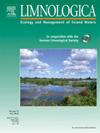小湖泊风浪和水流底应力的探索性模拟及沉积物再悬浮的潜力
IF 2
4区 环境科学与生态学
Q2 LIMNOLOGY
引用次数: 0
摘要
虽然湖泊通常被认为是长期的沉积物汇,但底部沉积物的再动员可能是重要的,并对水质和湖泊沉积物记录的古环境分析产生影响。风浪和风生海流是沉积物再悬浮最重要的驱动因素,但它们相互作用的复杂性及其间歇性使对这些过程的直接观测复杂化。本文介绍了一种将三维群落水动力模型(FVCOM)与参数化提取限制风波模型相结合的混合方法,以模拟不同气象条件下沉积物再悬浮对湖床相对比例的影响。对一个受强风影响的小型高原湖泊进行了模型验证和试验。一系列探索性模型实验表明,风速≤12 m s−1时,风波应力优于水流应力。因此,在低风速条件下,风波应力与电流应力之比可以在15左右,但当风速增大时,由于电流应力增长较快,该比值非线性地趋于1。在典型风速条件下的风向情景分析表明,风浪会使沿海岸的狭窄下风带的沉积物重悬。在不同的深度范围内,风浪只能在深度小于5 m的区域对沉积物进行再悬浮,而对于水流应力,在中间深度(5 ~ 15 m)对沉积物的再悬浮区域更为广泛。本文章由计算机程序翻译,如有差异,请以英文原文为准。
Exploratory modelling of wind-generated wave and current bottom stress and potential for sediment resuspension in small lakes
Although lakes are generally considered to function as long-term sediment sinks, remobilisation of bottom sediments can be significant and has implications for water quality and palaeoenvironmental analysis of lake sediment records. Wind-waves and wind-generated currents are the most important drivers of sediment resuspension but the complexity of their interaction and their intermittent nature complicate direct observation of these processes. This paper demonstrates a hybrid approach that combines a three-dimensional (3D) community hydrodynamic model (FVCOM) with a parameterised fetch-limited wind wave model to simulate the relative proportions of the lake bed subject to sediment resuspension under different meteorological conditions. Model validation and testing is undertaken for a small upland lake exposed to strong wind forcing. A series of exploratory model experiments indicate the dominance of wind-wave stresses over flow current stresses for wind speed 12 m s. Accordingly, the ratio between wind-wave stresses and current stresses can be around 15 for low wind speeds, but this ratio tends non-linearly to 1 when wind speed increases because of the faster growth of current stresses. The analysis of wind direction scenarios under typical wind speed conditions indicate that wind waves would resuspend sediments over narrow downwind zones along the shores. At different depth ranges, wind-waves are only able to resuspend sediments in areas less than about 5 m in depth, whereas for current-induced stresses, the resuspended area is more extensive for intermediate depths (from 5 m to 15 m).
求助全文
通过发布文献求助,成功后即可免费获取论文全文。
去求助
来源期刊

Limnologica
环境科学-湖沼学
CiteScore
3.70
自引率
5.90%
发文量
64
审稿时长
3 months
期刊介绍:
Limnologica is a primary journal for limnologists, aquatic ecologists, freshwater biologists, restoration ecologists and ecotoxicologists working with freshwater habitats.
 求助内容:
求助内容: 应助结果提醒方式:
应助结果提醒方式:


